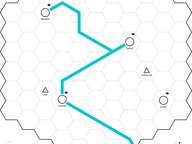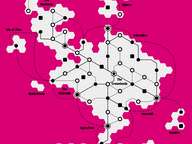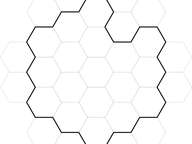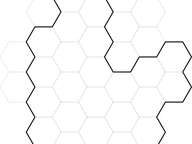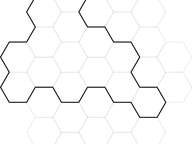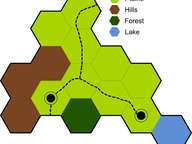I've tried solo hexcrawling before and it sucked. Too many things went wrong, so I stopped my attempt very early on. But the desire for a hexcrawl campaign still lingers in my heart. What could I change to make it more enjoyable? How can you avoid the same mistakes I did?
There are multiple factors why my first foray failed. The system was new and there were a lot of moving parts. My playkit consisted of (at least) three different books, a bunch of printed and laminated quick reference sheet and of course the usual roleplaying materials, such as paper, pencil and dice. I wanted too much. I forgot the the iron rule: Start Small. Start Simple.
Before I start something new, I need to take the lessons learned from that first attempt and streamline the whole process some more. I thought I could pack all my thoughts about this subject matter into one (albeit it long) article. It turns out, I have more to say than I thought, so I will split it into multiple parts. This first part will concentrate on the overall hexcrawl structure.
"Rulings over Rules" - a fundamental philosophy. What I'm writing here is just a framework that I myself use. Use as much as you wish from it. Mash it up so that it fits your playstyle. Or take it as a cautionary tale. Although written for solo play, it is usable for regular play as well.
Wilderness Exploration
The most time consuming part of the hexcrawl was rolling dice. For every hex, there were multiple rolls: One roll to determine the hex type (as I generated the hexes on-the-fly - randomly), one roll to determine any features of the hex, one roll to determine if there's an encounter and one (or two) rolls to see the outcome of the characters on what they were doing. And in between I had to check the books to see what these rolls even meant.
So I managed to do one hex in my first session. But this wouldn't have been the end of the (in-game) day. Forbidden Lands divides the day into four watches, each 6 hours long. Technically you could travel on each of these watches - although not advisable. So there would have been a lot more dice rolled.
Wilderness exploration has two extremes: Hexcrawl and Pointcrawl.
Pointcrawls are very abstract. Ironsworn makes use of these in most parts. Travel between point A and B is just defined by some amount of effort. The exact route or terrain is not important. What counts mostly is the relation between each site. I know that A is west of B and C is north of A. I might also know the distances, but my map might not be that accurate (scale wise). You just progress to your destination, but there's never a particular amount of time given. Each step could mean hours or days. You decide, depending on the narrative.
On the other hand we have hexcrawls. There's almost no abstraction. Distances are clearly defined. Generally a hex is 6 miles (or about 10km). There are rules on how far you can travel each day and if there's modifications of this travel time according to the type of hex you are on. Hexcrawling is crunchy. Mapping and taking measurements are at its core.
But isn't there some sort of middle-ground?
Starforged did go into such a direction. There is a sector map that is divided into hexes. When you travel you go from hex to hex. Space (in this sector) is somewhat evenly divided. You can also use the passages between established settlements. Then it becomes more of a pointcrawl.
1 hex = 1 day
The first concession that I make is the following: 1 hex = 1day. This limits the amount of rolls I have to do, when it comes to travel resolution.
With this, the size of an individual hex becomes abstract - which neatly also solves that whole discussion if a hex should be 3, 4, 6 or 8 (or whatever) miles, because of accuracy of how much a person could travel realistically in a day.
But shouldn't it take longer to travel across mountains for example?
Yes, sure. But since the hexes don't have a particular size, the total area covered by that mountains is much smaller than an open field. It just always takes one day to traverse a hex. Maps, especially if you take "primitive" mapmaking into consideration, are newer that accurate anyway.
It also provides a neat feature: You can always guess how long a travel takes from any point on the map to another. I do like when I can get the state of a game by just a quick glance and don't have to do a lot of maths. This is particularly important during solo play.
The other thing is, that you can - similar to Starforged - still point crawl between each of the cities or sites if you so wish. If two points of the map are interlinked with a road, you could just resolve that travel as one roll (if something happens on the road).
Image Courtesy of Knight and the Opera
1 hex = 1 roll
The second concession I make is the amount of rolls I do: 1 hex = 1 roll. Instead of rolling dice multiple times per day, there's just one roll to determine if something happens or not during travels.
This might contradict certain rules of the chosen game system.
Shadowdark RPG let's you travel for 8 hours per day. Depending on how dangerous the area is, you can roll up to 8 dice in that period. But it's more likely you roll 3 to 4 dice.
Knave2e splits the day in 6 watches. You can travel in up to three of those normally. And each watch has a roll of the encounter die. So that's 3 rolls for travelling.
Forbidden Lands knows 4 watches as already mentioned. Normally you travel on two of them, so that's 2 rolls.
These rolls are kind of important, as they introduce conflict to the characters, give them something to do and make travels perilous. The more often you roll dice, the more likely it is that something is happening. With reducing the amount of rolls, we remove that conflict.
If you look closer, then there's maybe 2-3 rolls each day for travel. One way you could solve this is to just increase the probabilities of "failing". If there was a 1-in-6 chance to get an encounter you could increase it to 1-in-2 or 1-in-3. Rolling a one in 3 dice is about 42%, so 1-in-2 makes a good approximation.
The same holds for getting lost. Each hex you need to roll if you get lost or not. That's about 2-3 rolls as well. Here the probabilities are much different, since here the players are rolling with their characters' skills. Normally chances are much better, since they will roll with the skill they are best at. This can be adapted by increasing the DC. Or you can combine everything into one roll. Let the characters roll and if they fail, then let an encounter happen or let them get lost. You can even make the roll unmodified. It removes a bit of player agency, true, but you could see it similar to rolling for encounter in a dungeon.
The matter of rolling for encounter I will discuss in the next article. For now lets just use a simple 1-in-2 chance of an encounter happening.
Setting up the Crawl
The other thing that bothered me, was the random generation of the map. There was too much upkeep and rolling involved in this. In theory the idea behind was good. I wanted to be surprised on what I might find on each hex. This represents how a hexcrawl would go, when you would have a GM.
Or is it?
One could argue, that the game is as enjoyable if you would see the full map. Heck, I would even argue, that it is way better.
Take the map from Elden Ring. You can gather pieces of the map in-game and it would reveal a portion of the full world map. You would look at it closely to find hidden details, set a marker and then ride to that point. Breath of the Wild did the same. The game should not be to find out what terrain that particular spot of the world has, but rather what can be found there.
So the solution is to generate the map beforehand.
Provinces
Similar to Starforged we are not taking on the full world at once. But rather a small piece of it - a Province. A sector of the world if you will. It would follow that the local ruler(s) would have a map of their land and the citizens would roughly know what the lay of that land was.
Remember, that our hexes are just an abstract representation of size. A farmer would know that if you travel two days in a certain direction you would reach another village and you should take special care of that scary forest in between. They would not know what is in the forest, that makes it so scary. But they know that it is there. Such information alone should be enough for anyone to create a rough map of the region.
And that is what we are going to create. Prep is Play.
The general consensus is to start with a 10x10 hexmap. But I find that boring and way too much. I came upon an interesting method in Broken Shore / Godshard. You would sail around until you found and island and then you'd roll to see, how big the island was. That would give you the amount of hexes that you outlined the island on a predefined grid. This also gives you different shapes of your provinces which is a nice little extra.
Godshard uses a simple d20 roll to determine the size. I've gathered some other ways to roll for the size, based upon that.
| Method | Min (Chance) | Mean (Chance) | StdDev |
|---|---|---|---|
| 1d20 + 10 | 11 (5%) | 20.5 (5%) | 5.77 |
| 4d6 + 6 | 10 (0.08%) | 20 (11.27%) | 3.42 |
| 2d12 + 6 | 8 (0.69%) | 19 (8.33%) | 4.88 |
| 3d10 | 3 (0.1%) | 16.5 (7.5%) | 4.97 |
| 2d10 + 10 | 12 (1%) | 21 (10%) | 4.06 |
As soon as you roll more than one die, you leave the realm of uniformly distributed chances of course. So you would have very similar results each time you roll, but the extremes are much less likely. I'm personally liking 4d6+6 and 2d12+6, but you can take any method you like. The result is, that you should get a number somewhere between 10 and 30. 3d10 isn't that great, since you could get very small provinces that way.
I prepared a simple hexgrid for provinces. Just outline the size of your province on this sheet. Again, you could take any hexgrid to do so.
Here are some examples of province shapes you could generate with this.
Adding some life
Now we need some stuff on that map, so that it is worth being explored. We will start with adding some terrain to the hexes. Use any method you can find and that you are familiar with to generate those hexes or come up with something yourself (Again there will be more details coming soon). Some good ways are for example Hexflowers. But you could even just go with a simple random table.
Next we should put some settlements on there. People are living in these provinces after all. Plus you want some points to orient yourself and rest after your adventures.
There are two methods you can do here:
- Roll a d12 for each hex and on a 12 put a settlement on that hex
- Determine at random (d4 for example) or choose a number of settlements the province should have and put them into your province
A settlement could be anything from a small village, to a bustling city, a fort or something else. Roll on the following table if you need inspiration.
| d12 | Type |
|---|---|
| 1 | Camp |
| 2 | Hamlet |
| 3 | Village |
| 4 | Small Town |
| 5 | Large Town |
| 6 | Small City |
| 7 | Large City |
| 8 | Castle |
| 9 | Castle Town |
| 10 | Garrison |
| 11 | Manor |
| 12 | Tower |
Next draw some roads, between the settlements and one road should possibly enter and exit the province. If you want you can also draw some rivers.
A finished map could look something like this.
Conclusion
We now have a map we can move around and have some random adventures. But there's not much happening yet once you've reached a hex. A problem I will solve at a later time as well.
This province generation is influenced and inspired by Starforged. I liked it during my #Solo23 playthrough so I added some things to it, that I enjoy and want. I didn't want to invent the wheel anew.
Summary
Before play, create a province by
- Rolling 2d12 + 6, this determines the size of your new province
- Outline your province on a hexgrid paper, the size should match the rolled result
- Add terrain to your province
- For every hex in your province roll a d12 and put a settlement on every hex that rolled a 12
- Draw roads between settlements as you see fit
- Draw at least one road that enters and exits the province
- Draw rivers in the province as wanted
To play
- Start on any settlement
- It takes one (1) in-game day to move to any adjacent hex of your current position (1 hex = 1 day)
- Whenever you move a hex, roll the encounter die. Whenever you roll an odd number, an encounter happens (1 hex = 1 roll)
Further Reading: Solipsistic hexes, Hexcrawl Checklist: Part One, Just Three Hexes
